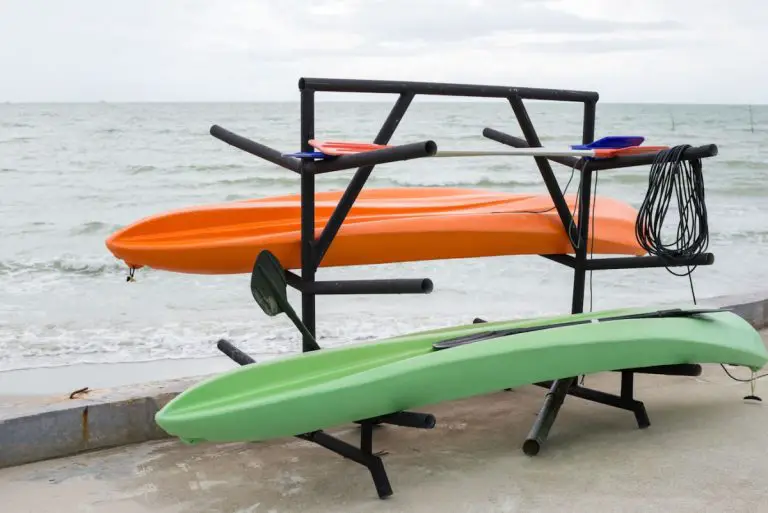Do You Need Bow And Stern Tie Downs For Kayaks? (Explained)
You’ve probably seen canoes being carried on the top of a car that has bow and stern tie-downs. But what about kayaks? Do you need bow and stern tie-downs for kayaks? Let’s figure that out.
You need a bow and stern tie-down for transporting your kayak on an auto rooftop in order to prevent a sudden start or stop from shifting your kayak forward or backward with great force. Securing tie-downs on the bow and stern of a kayak is an important safety measure when car topping any kayak.
Bow and stern tied downs are a safety precaution for kayaks and their owners. You use them while transporting the kayak to your desired location. If you want to know more about bow and stern tie-downs for kayaks, then keep reading for more information.

Do You Need Bow And Stern Tie Downs For Kayaks?
Bow and stern tie-downs are essential for transporting kayaks via a car’s rooftop. While your kayak may already be secured with straps, bow and stern tie-downs prevent the kayak from shifting forward or backward during travel, especially during sudden starts or stops.
No matter how tight the straps holding down your kayak are, a quick stop can create enough force that your kayak shoots forward like a missile. Having bow and stern lines attached to the front and rear of your kayak and vehicle will prevent your kayak from suddenly shifting forwards or backward.
Having bow and stern tie-downs while transporting your kayak on the roof of your car is absolutely a necessary safety precaution.
What Bow And Stern Tie-Downs Do You Need For Kayaks?
You need tie lines (1/4 – 1/8 inch. or 6–9 mm diameter nonstretch line) from the bow and the stern of your kayak to the vehicle (most modern bumpers make this somewhat of a challenge).
It would be in your best interest to anchor each line at two points to form an “A” shape (see image above). These lines help stabilize the kayak in high winds and while moving down the road. They may also buy you some time if one of your main tie-down straps fails. [1]
Several different types of tie-downs exist and all will work just fine as long as the material isn’t stretchy. Ropes or tie downs with a lot of give will not work for this purpose. You can also work with tie straps. Tie straps are a form of tie-downs but are flat straps rather than round like ropes and usually have a ratchet mechanism.
The Purpose Of Bow And Stern Tie Downs
While general tie-down straps will securely hold a kayak on an auto roof in most situations, bow and stern tie-down straps add an additional degree of safety.
Out-of-water accidents are one of the most common boat accidents. The main cause of these accidents is improper securing during transportation. (source)
The Law Behind Bow And Stern Tie Downs
The U.S. Coast Guards’ Boating Safety Division (The USCG) shows that bow and stern tie-downs are necessary for all sea vessels, kayaks included. There is also the issue with local authorities. Some local authorities make the bow and stern tie-downs mandatory while transporting any vessel. (source)
It would be best to check with your local authority before car topping your kayak. You wouldn’t want to be on the wrong side of the law because you didn’t know that specific law existed.
Ignorance of the law will not prevent you from getting a ticket or being fined if your kayak isn’t secured properly to your automobile.
What To Consider When Car Topping A Kayak
Apart from tie downs, there are numerous other considerations you need to think about when you’re cartopping a kayak. Here are a couple of pointers that every kayak owner should know.
1. Protecting The Kayak And The Vehicle
Clean grit off the bottom of foam blocks, use a bath mat or thick towel to protect the back edge of the roof, and remember to hose off saltwater that may remain on the roof of your vehicle. Why do you do this? You do this to prevent scratching or abrasions on your vehicle and kayak. [1]
2. Proper Support Of The Kayak On The Car
The core of your support should be at the bulkhead. It is generally a more robust area, and you can carry your kayak on either its side or hull. These areas are less prone to flexing. Remember to brush off grit from all areas placed in cradles or foam blocks so the kayak won’t suffer from abrasions. [1]
3. Getting Comfortable With Your Cartop Kayak System
It would be in your best interest to secure your kayak to your cartop rack and your rack to your vehicle. Whether you’re using foam blocks or any other cartop system, the method remains the same. You also need to be aware of the load limit of your cartop system.
4. Consider A Backup Line When Car Topping a Kayak
Tie-downs offer excellent security for your kayak; however, they can falter if you are traveling over long distances or if you expect your trip to have strong winds. In these instances, you may have to invest in backup lines to doubly secure your kayak.
Boat owners often refer to backup lines as a perimeter, belly, or line. If any part of your cartop system fails, the line may buy you enough time to pull off the road (without losing your kayak).
Is It Worth It Having Bow And Stern Tie Downs For Kayaks?
Most experts agree that bow and stern tie-downs are necessary when transporting kayaks via rooftop. Bow and stern tie-down lines should always be used when carrying a kayak on a car, regardless of whether or not they are required by law.
Anything that you can do further secure your vessel when driving down the road is a worthwhile idea.
Sources:
- Shelley Johnson, THE COMPLETE SEA KAYAKER’S HANDBOOK, (New York: McGraw Publishing, 2001) 353.
- USCG Boating, A BOATER’S GUIDE TO THE FEDERAL REQUIREMENTS FOR RECREATIONAL BOATS AND SAFETY TIPS, USCG Boating, Accessed March 24, 2022, https://www.uscgboating.org/images/420.PDF.
- U.S Department of Homeland Security, United States Coast Guard, 2020 Recreational Boating Statistics, (Washington D.C: U.S Department of Homeland Security, 2020) https://uscgboating.org/library/accident-statistics/Recreational-Boating-Statistics-2020.pdf.
- Chapter 2 – Marine vehicle types, Editor(s): Anthony F. Molland, The Maritime Engineering Reference Book, Butterworth-Heinemann, 2008, Pages 43-74, ISBN 9780750689878, https://doi.org/10.1016/B978-0-7506-8987-8.00002-0. (https://www.sciencedirect.com/science/article/pii/B9780750689878000020)







